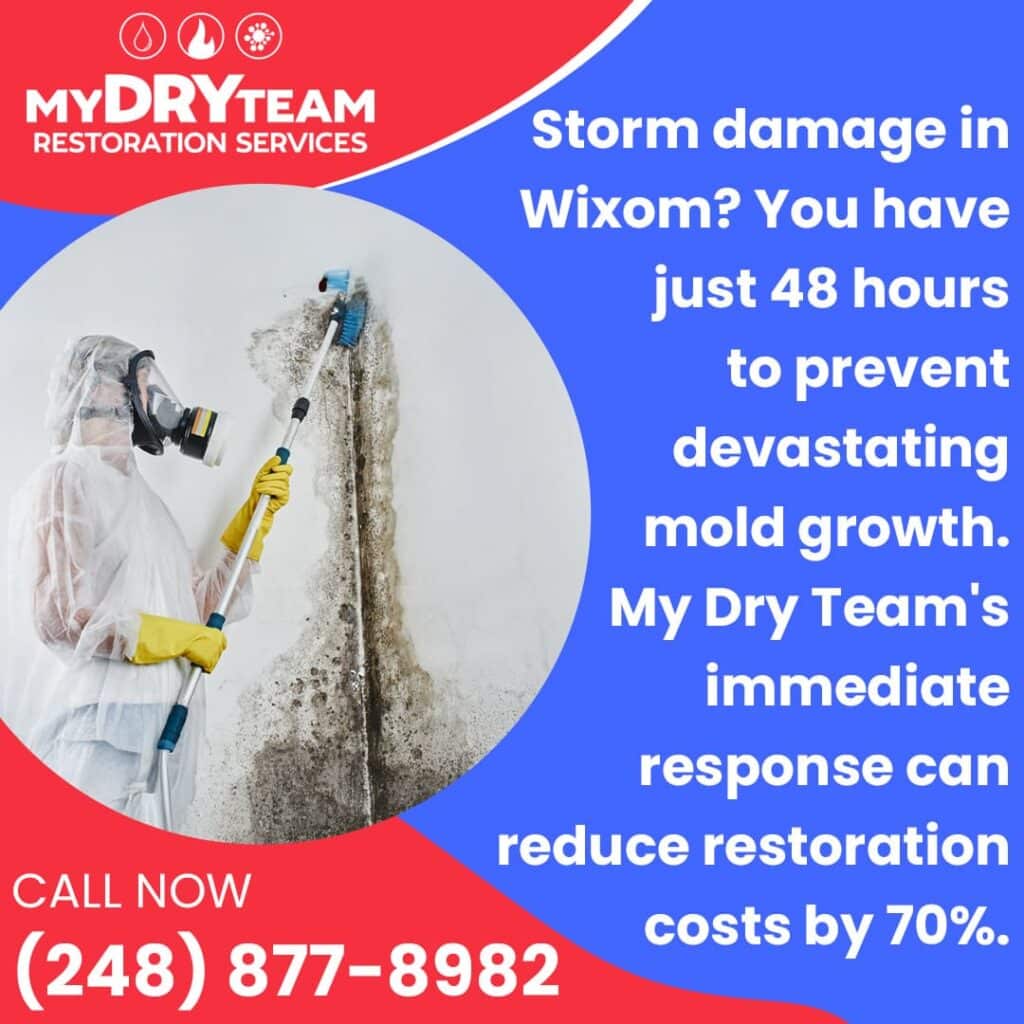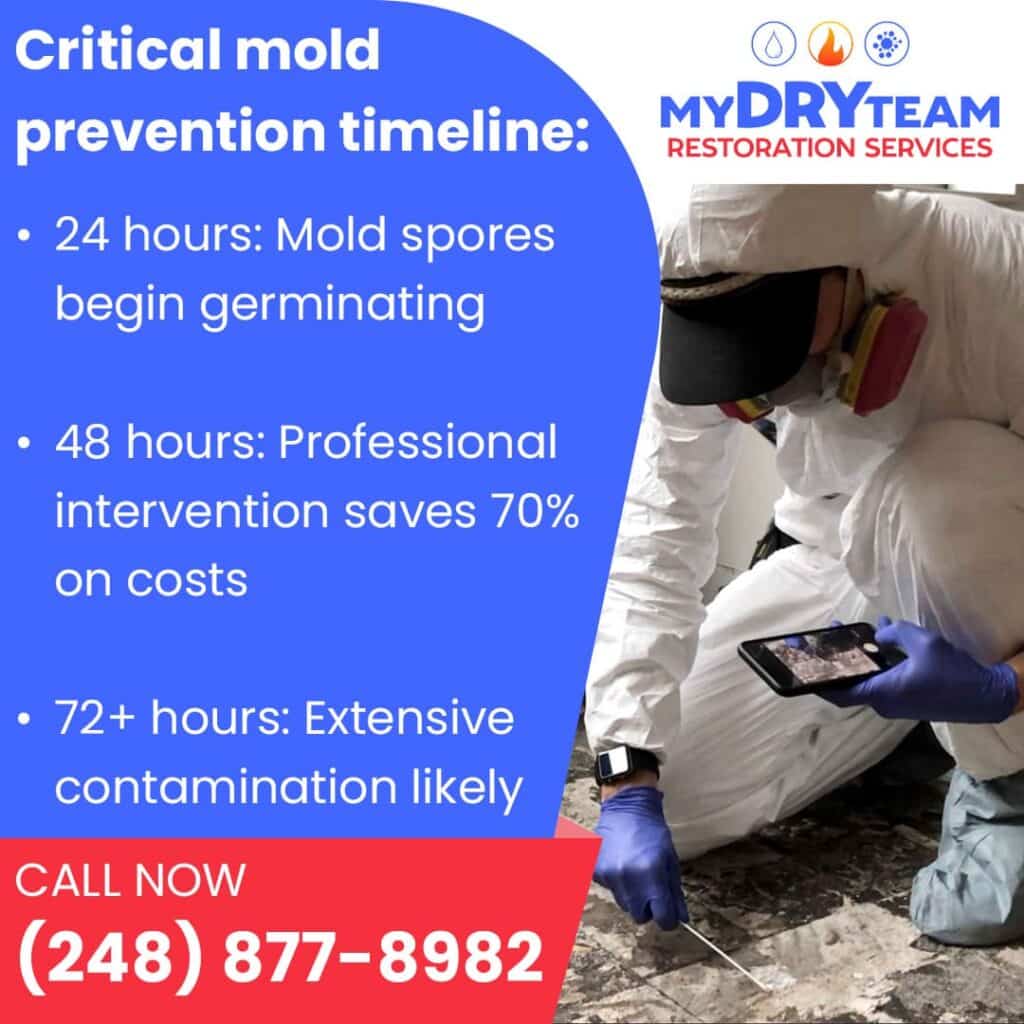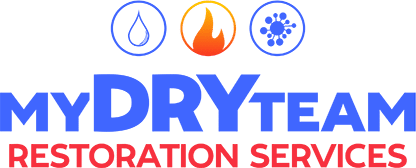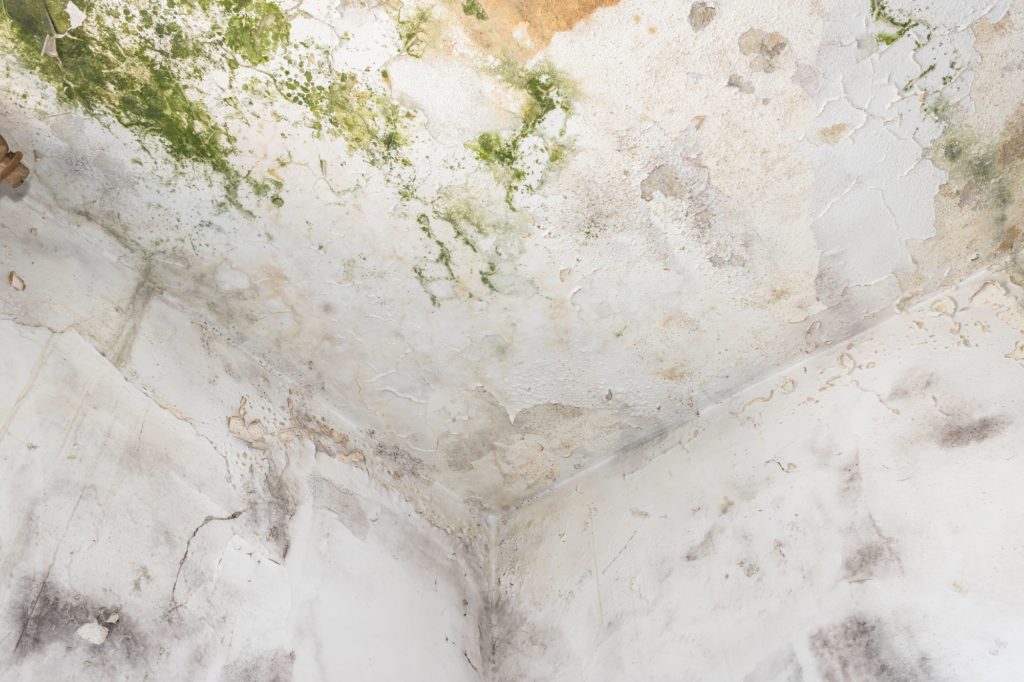After storm damage and flooding, mold can begin forming within 24 to 48 hours, making immediate response critical. Homeowners should first focus on safety, shutting off power if necessary, and documenting all damage for insurance purposes. Quick steps such as removing standing water, improving airflow, and using dehumidifiers can slow mold development, but moisture often lingers in hidden areas like walls, flooring, and crawl spaces. Without proper detection, these damp zones allow mold to spread rapidly. Professional mold remediation employs advanced equipment, structural assessments, and containment methods to stop further damage, restore affected spaces, and reduce the risk of recurring issues after future storms.

The Critical 24-48 Hour Window After Storm Damage
When storm damage and flooding strike Wixom homes, we understand the overwhelming feeling that follows. At My Dry Team Restoration Services, we’ve witnessed firsthand how quickly water damage can escalate into a serious mold problem. The truth is, mold spores can begin germinating within 24 to 48 hours after water exposure, making immediate action critical for protecting your home and family.
We’ve responded to countless emergency calls in Commerce Township and surrounding areas where homeowners waited too long to address water damage, only to face extensive mold remediation needs weeks later. The difference between a manageable cleanup and a major mold crisis often comes down to the actions taken in those first critical hours. While we’re always ready to respond at (248) 877-8982, homeowners should understand what they can do immediately to minimize mold growth before professional help arrives.
Understanding Post-Storm Mold Development
How Quickly Mold Spreads After Water Damage
Through our years of experience in mold removal, we’ve observed that Michigan’s humid climate creates ideal conditions for rapid mold proliferation. Within the first 24 hours after flooding, mold spores that are naturally present in the air begin to settle on wet surfaces. By hour 48, these spores start developing into active colonies, and by day three, visible mold growth often appears.
We frequently encounter hidden moisture pockets during our assessments—areas behind walls, under flooring, and in ceiling cavities where water has seeped unnoticed. These concealed damp zones become breeding grounds for mold, which is why professional moisture detection is so critical. The temperature fluctuations common in Wixom, especially during spring and fall, accelerate this process as warm, moist air creates condensation in cooler spaces.
Types of Mold Common After Michigan Storms
In our mold remediation work across Oakland County, we regularly identify several mold varieties that thrive after storm flooding. Stachybotrys chartarum, commonly known as black mold, is perhaps the most concerning due to its potential health impacts. We often find it growing on water-damaged drywall and wood framing materials.
Aspergillus and Penicillium species are equally common in flood-damaged homes, particularly in basements where organic materials like cardboard boxes and fabric have gotten wet. We’ve also noticed an increase in Chaetomium growth, which produces a musty odor and typically indicates long-term moisture problems. Each type requires specific removal techniques, which is why proper identification is critical for effective mold clean-up.
Immediate Actions to Take After Storm Flooding
Safety First: Before Entering Your Flooded Home
We cannot stress enough the importance of safety when dealing with storm damage. Before entering your flooded property, we recommend turning off the main electrical breaker if it can be accessed safely from a dry area. Never wade through standing water if electrical outlets or appliances are submerged. We’ve seen too many accidents that could have been prevented with proper caution.
Structural damage is another serious concern we evaluate during every emergency response. Flooding can compromise foundations, weaken support beams, and damage load-bearing walls. If you notice sagging ceilings, cracks in walls, or doors that won’t close properly, these are signs that professional assessment is needed immediately. At My Dry Team Restoration Services, we provide comprehensive structural evaluations as part of our initial response.
Document Everything for Insurance
Through our extensive experience helping homeowners with insurance claims, we’ve learned that thorough documentation makes a significant difference in claim outcomes. We recommend taking photos and videos of all damage before beginning any cleanup efforts. Capture wide shots of each affected room, followed by close-ups of damaged items and structural elements.
Creating a clear inventory helps prevent items from being missed during the claims process. List each damaged belonging along with its approximate age and value. Keep receipts for emergency repairs and temporary living costs. When My Dry Team Restoration Services arrives for mold remediation, the team provides thorough documentation to support your insurance claim, including moisture readings, measurements of affected areas, and detailed treatment records.
DIY Emergency Mold Prevention Steps
Water Extraction and Drying Techniques
While we always recommend professional water extraction for significant flooding, we understand that homeowners often need to take immediate action. If you choose to begin water removal yourself, we suggest starting with a wet/dry vacuum for standing water. Position fans to create cross-ventilation, pointing them at wet walls and floors rather than directly at visible mold, which can spread spores.
We’ve observed that many homeowners make the mistake of closing windows to run heating or air conditioning. However, unless outdoor humidity exceeds 60%, opening windows actually helps with the drying process. Industrial dehumidifiers work best, but even residential units can help when placed strategically in affected areas. Remember, these are temporary measures—professional drying equipment is necessary to prevent mold growth in hidden areas.
Salvaging vs. Discarding Water-Damaged Items
Making decisions about what to save and what to discard can be emotionally challenging. Through our years of mold removal experience, we’ve developed guidelines to help homeowners make these tough choices. Generally, we recommend discarding porous materials that have been submerged in contaminated floodwater for more than 48 hours. This includes carpeting, padding, upholstered furniture, and mattresses.
However, many items can be saved with proper treatment. We often successfully restore hardwood furniture, important documents through freeze-drying, and even some electronics if they’re addressed quickly. The key is preventing mold growth during the drying process. Items should be moved to a dry, well-ventilated area and cleaned with appropriate antimicrobial solutions.
Professional Mold Remediation Process After Storm Damage
Why Professional Help Is Essential
We understand the temptation to handle mold clean-up independently, but professional intervention is critical for several reasons. First, we use specialized equipment like thermal imaging cameras to detect hidden moisture, industrial-grade air scrubbers with HEPA filtration, and professional-strength antimicrobial treatments that aren’t available to consumers.
Following IICRC standards allows mold remediation to be performed in a safe and effective manner. Containment barriers are set up to stop spores from spreading, negative air pressure is applied to protect areas that are not impacted, and post-remediation testing is carried out to confirm that mold has been removed. Without this professional process, mold can return within weeks or months, causing greater damage and higher expenses.
What to Expect from My Dry Team’s Emergency Response
When you call My Dry Team Restoration Services for storm damage assistance, we begin with a comprehensive assessment using moisture meters and thermal imaging to map all affected areas. Our water extraction process removes both standing water and moisture from carpets, padding, and subfloors using powerful truck-mounted equipment.
We place commercial dehumidifiers and air movers in key areas of the property to speed up drying. Antimicrobial treatments are applied to remove existing mold and help prevent it from returning. Moisture levels are tracked daily, and equipment is repositioned when needed to support complete drying. Air testing is conducted to verify that mold spore levels are back to a safe range before the work is finalized.
Room-by-Room Mold Combat Strategies
Basement and Crawl Space Mold Prevention
Basements and crawl spaces present unique challenges in our Michigan climate. We frequently find that these areas retain moisture long after the rest of the home has dried. Installing a properly functioning sump pump with battery backup is crucial, as we’ve seen power outages during storms render standard pumps useless when they’re needed most.
We recommend applying waterproof sealants to foundation walls and installing vapor barriers in crawl spaces. Professional-grade dehumidification systems designed for below-grade spaces maintain optimal humidity levels year-round. During our mold remediation projects, we often discover that inadequate ventilation in these areas has created chronic moisture problems that predate the storm damage.
Living Spaces and HVAC Systems
HVAC systems require special attention after flooding because they can distribute mold spores throughout your entire home. We always inspect and clean ductwork as part of our comprehensive mold removal process. Contaminated insulation within walls must be removed and replaced, as it’s impossible to properly dry and can harbor mold for years.
Different flooring types require different approaches. While we can often save hardwood floors through specialized drying techniques, laminate flooring typically needs replacement after significant water exposure. We use moisture meters to test subfloors thoroughly, as trapped moisture here leads to persistent mold problems.
Insurance Coverage for Post-Storm Mold Issues
Understanding Your Policy’s Mold Coverage
Through our extensive experience working with insurance companies, we’ve learned that mold coverage varies significantly between policies. Most standard homeowner’s policies cover mold damage resulting from sudden and accidental water damage, such as storm flooding, but often cap mold remediation coverage at $5,000 to $10,000.
We always emphasize the importance of immediate action, as insurance companies may deny claims if they determine that mold resulted from neglect rather than the initial storm damage. At My Dry Team Restoration Services, we help document the direct connection between storm damage and mold growth, strengthening your claim’s validity.
Common Mistakes That Lead to Mold After Flooding
DIY Errors That Worsen the Problem
We frequently encounter situations where well-intentioned DIY efforts have actually accelerated mold growth. Using bleach on porous surfaces is perhaps the most common mistake—while it may lighten mold stains, it doesn’t kill mold roots and adds moisture that promotes further growth. Similarly, painting over mold without proper remediation only masks the problem temporarily.
Another critical error we see is inadequate drying time. Many homeowners begin repairs after surfaces feel dry to the touch, not realizing that moisture meters would show dangerous levels still present within materials. This trapped moisture inevitably leads to mold growth behind new drywall or under new flooring, requiring costly removal of recently completed repairs.
Health Concerns During Post-Storm Mold Clean Up
Protecting Your Family During Remediation
We prioritize family safety throughout every mold remediation project. Depending on the extent of contamination, we may recommend temporary relocation, especially for family members with respiratory conditions, compromised immune systems, or allergies. Our containment procedures prevent spore spread, but sensitive individuals may still experience reactions.
We continuously monitor air quality during the remediation process, providing daily reports on spore counts and safety levels. Pet safety is equally important—we advise keeping animals away from affected areas and consulting with veterinarians if pets show signs of mold exposure, such as excessive scratching, respiratory issues, or lethargy.
Act Fast to Protect Your Home and Health
Storm damage and flooding demand fast response with the right actions. The decisions taken within the first 24 to 48 hours often determine whether the outcome involves limited water damage or extensive mold remediation. Although some early steps can be handled on your own, professional service is needed for complete moisture removal and to reduce the risk of ongoing mold issues.
At My Dry Team Restoration Services, we’re committed to helping Wixom homeowners navigate these challenging situations. Our comprehensive approach addresses both immediate water damage and long-term mold prevention, protecting your property value and your family’s health. Don’t let storm damage evolve into a mold crisis—swift, professional action is your best defense against the cascade of problems that water damage can trigger.

About My Dry Team Restoration Services
My Dry Team Restoration Services has been the trusted leader in mold remediation and water damage restoration throughout Wixom, Commerce Township, and Oakland County for years. We understand that storm damage doesn’t wait for convenient times, which is why we maintain 24/7 emergency response capabilities. IICRC-certified technicians apply advanced equipment and proven methods to deliver complete mold clean-up and prevention.
We pride ourselves on our comprehensive approach that goes beyond simple water extraction. From initial emergency response through final restoration, we handle every aspect of storm damage recovery. Our team works directly with insurance companies to streamline the claims process, providing detailed documentation and direct billing when possible. We believe in transparent communication, keeping you informed at every step, and ensuring you understand the remediation process.
When storm damage threatens your home, you need a restoration partner you can trust. Contact My Dry Team Restoration Services today at (248) 877-8982 or email us at office@mydryteam.com for immediate assistance. Don’t wait for mold to take hold—our rapid response team is ready to protect your home and restore your peace of mind. Visit them at Martin Rd, Commerce Township, Michigan, or explore our services on our website. Let us show you why homeowners throughout Southeast Michigan trust us with their most challenging restoration needs.

